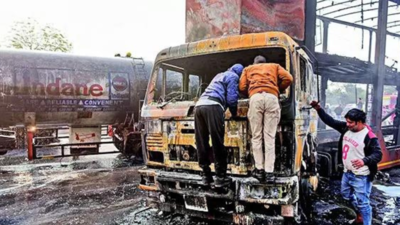JAIPUR: The death toll rose to 13 from Friday’s devastating LPG tanker explosion following a collision with a truck on Jaipur-Ajmer national highway at Bhankrota, as two more people with severe burns died during treatment Saturday. Rajasthan police said Friday’s toll has been revised to 11, down from the initially reported 12. The earlier count included five unidentified bodies, but it was later discovered that one found in pieces was counted twice. Of the four unidentified bodies, two were identified Saturday – former IAS officer Karni Singh and a trailer driver.
The two men who died Saturday were both from Rajasthan – identified as 20-year-old Faizan from Udaipur and Govind Narayan, 32, a resident of Kekri district. They were among 26 patients admitted to govt-run Sawai Man Singh (SMS) hospital in Jaipur – nearly 15km from the accident site. Seven others are receiving care at private hospitals in the city.
Three survivors, battling severe burns and respiratory damage caused by toxic fumes from the explosion, remain in critical condition at SMS. All three – 45-year-old Yosuf from Bhilwara (90% burns); Naresh, 28, from Madhya Pradesh (80%); and 23-year-old Vijeta from Banswara (70%) – are on ventilator support in ICU.
Doctors highlighted the unusual severity of the injuries. “Those who died suffered severe lung and respiratory tract injuries due to fumes (emitted during the LPG explosion),” said Dr RK Jain, head of burn and plastic surgery at SMS hospital.
“It is something different that we noticed in this case. If a person has 90% burn injuries and their lungs and respiratory tract are also damaged due to fumes, the survival of such patients becomes difficult. All those who died in the Bhankrota accident had deep burns in their lungs and respiratory tracts due to fumes.”
The patients are also grappling with burn shock caused by hypovolemia, a loss of intravascular fluid. Doctors have been administering intravenous (IV) fluids and antibiotics to prevent infections and stabilise the patients.
“To administer IV fluid, we could not find the peripheral line (nerve) in some patients, so we had to use a central line through the neck and groin. After 72 hours, we will examine them and adjust the treatment as needed,” Dr Jain added.




Leave a Comment